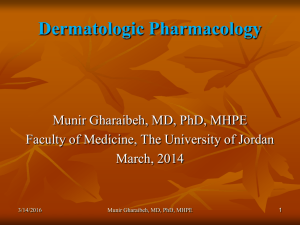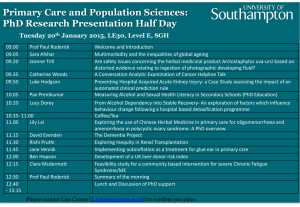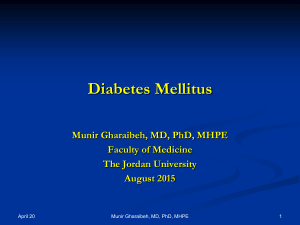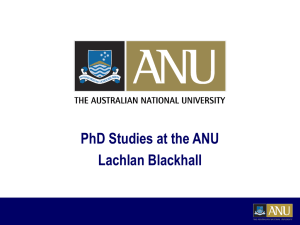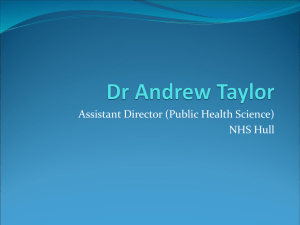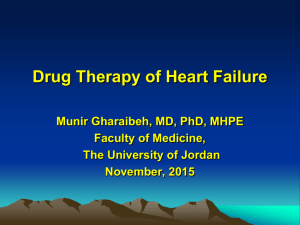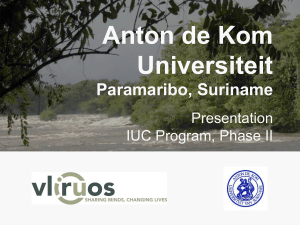PPT
advertisement
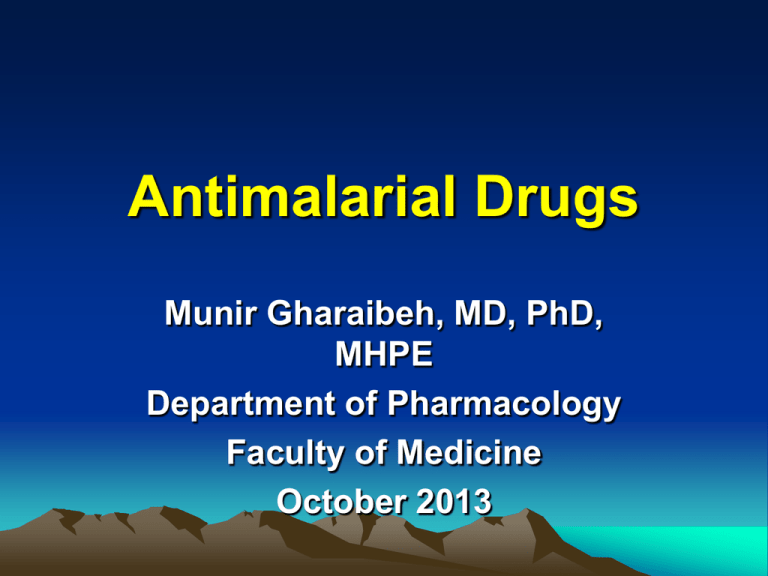
Antimalarial Drugs Munir Gharaibeh, MD, PhD, MHPE Department of Pharmacology Faculty of Medicine October 2013 Antimalarial Drugs • Annual Global Incidence: • 219 million in 2010. • Annually, in Africa, I million children die. • Suppressive Treatment = Clinical Cure: Chloroquin, Quinine, Quinidine, Doxycyline, Clindamycin, Mefloquine, and Halofantrine. • Radical Cure: Chloroquin followed by Primaquine, required for P vivax and P ovale. • Prophylaxis: Chloroquin, Mefloquin, April 15 Munir Gharaibeh, MD, PhD, MHPE 2 Malarial Parasites • Plasmodium falciparum (erythrocytic, serious, resistance). • Plasmodium vivax • Plasmodium malariae( erythrocytic) • Plasmodium ovale April 15 Munir Gharaibeh, MD, PhD, MHPE 3 April 15 Munir Gharaibeh, MD, PhD, MHPE 4 Chloroquine Synthetic 4-Aminoquinolone Specific uptake mechanism is present in the parasite, the drug accumulates in the parasite food vacuoles to inhibit polymerization of heme into hemozoin and thus parasite is poisoned by heme. Well absorbed, distributed, bound to tissues (VDL 100-1000L/Kg, Liver 500x). April 15 Munir Gharaibeh, MD, PhD, MHPE 5 Chloroquine Destroys the blood stages of all four types of malaria. Drug of choice in the treatment of nonfalciparum and sensitive falciparum malaria. Does not eliminate dormant liver forms of P. vivax and P. ovale, so, Primaquine must be added for their radical cure. April 15 Munir Gharaibeh, MD, PhD, MHPE 6 Chloroquine Resistance: Very common with P. falciparum and increasing with P.vivax. Mutation in P170 glycoprotein (PfCRT) works as a drug-transporting pump mechanism . April 15 Munir Gharaibeh, MD, PhD, MHPE 7 Chloroquine • Very practical, convenient, rapid action, low cost and safety. • Stat. • After 6 hours • After 24 hours • After 48 hours . However, does not eliminate dormant liver forms of P.vivax and P.ovale. April 15 Munir Gharaibeh, MD, PhD, MHPE 8 Chloroquine Also effective in: Rheumatoid arthritis. LE. Amebic liver abscess. Photoallergic reactions. Clonorchis sinensis. April 15 Munir Gharaibeh, MD, PhD, MHPE 9 April 15 Munir Gharaibeh, MD, PhD, MHPE 10 Chloroquine Side Effects: Headache, dizziness, Itching is common, rash, Nausea, vomiting, anorexia Unmasking of LE, psoriasis and porphyria. Corneal deposits, blindness, blurring of vision, Hydroxychloroquin Amodiaquin April 15 Munir Gharaibeh, MD, PhD, MHPE 11 Quinine(1820) and Quinidine Cinchona tree. General protoplasmic poison: will affect the feeding mechanism of the parasite. Resistance is uncommon. Effective rapid schizontide therapy for severe falciparum, chloroquine-resistant malaria, usually in combination with another drug (e.g. Doxycycline or Clindamycin) to shorten duration of use. April 15 Munir Gharaibeh, MD, PhD, MHPE 12 Quinine(1820) and Quinidine • Also effective for Babesia microti infection. • Also, for nocturnal leg muscle cramps (Arthritis, DM, thrombophlebitis, arteriosclerosis, varicose veins) April 15 Munir Gharaibeh, MD, PhD, MHPE 13 April 15 Munir Gharaibeh, MD, PhD, MHPE 14 Quinine(1820) and Quinidine Adverse Effects: Cinchonism: Tinnitus, headache, nausea, dizziness, flushing, visual disturbances. Later, auditory abnormalities, vomiting, diarrhea, and abdominal pain. Blood dyscrasias. Hypersensitivity, hypoglycemia, uterine contractions. Hypotension, QT prolongation. Blackwater fever (hemolysis, hemoglobinemia, April 15 Munirfailure) Gharaibeh, MD, PhD, MHPE hemoglobinurea, and renal 15 Mefloquine • Blood schizonticide, not for liver forms. Used for resistant P. falciparum (single oral dose ). Also for suppressive and prophylactic treatment (weekly doses). • Nausea, vomiting, diarrhea, pain. • Vertigo, dizziness, headache, rashes and visual alterations. • Psychosis, hallucinations, confusion, anxiety, depression. April 15 Munir Gharaibeh, MD, PhD, MHPE 16 Primaquin • 8-aminoquinolone Unknown mechanism. Drug of choice; the only available one, for eradication of exoerythrocytic forms of malaria after treatment with chloroquin. Hemolysis in G6PD deficient patients. Also, nausea, distress, headache, pruritis, leukopenia and agranulocytosis. April 15 Munir Gharaibeh, MD, PhD, MHPE 17 Atovaquone and Proguanil • Usually in fixed combination = “Malarone”. • Recommended drug for prophylaxis. • Atovaquone also approved for P.jiroveci pneumonia, although has lower efficacy than Trimethoprim-sulfamethaxazole combination. • Can cause fever, rash, nausea, vomiting, diarrhea, headache, and insomnia. April 15 Munir Gharaibeh, MD, PhD, MHPE 18 Pyrimethamine Inhibits DHF Reductase Slow and long acting drug. Effective on erythrocytic forms of all species. Not for severe malaria. Preferential binding to parasitic enzyme. Usually combined with Sulfadoxine” Fansidar” or Sulfones which inhibit Dihydropteroate synthase. No longer recommended for prophylaxis. Also, for Toxoplasmosis( in higher doses ), and P. jeroveci. April 15 Munir Gharaibeh, MD, PhD, MHPE 19 Pyrimethamine Adverse Effects: Anorexia, Vomiting, Leucopenia, Thrombocytopenia, glossitis CNS: Stimulation, Convulsions Allergic reactions including Stevens-Johnson Syndrome April 15 Munir Gharaibeh, MD, PhD, MHPE 20 Antibiotics • • • • • Tetracycline. Doxycycline. Clindamycin. Azithromycin. Fluoroquinolones. Active against erytrocytic forms of all species. Usually for chloroquine-resistant strains. Also effective against other protozoal diseases. April 15 Munir Gharaibeh, MD, PhD, MHPE 21 Halofantrine and Lumefantrine Rapidly effective against erythrocytic forms of all species. Usually for chloroquine-resistant strains. Well tolerated, except for cardiac toxicity (QT prolongation) April 15 Munir Gharaibeh, MD, PhD, MHPE 22 Artemisnin= Qinghaosu • Artesunate. • Artemether. • Derivatives of Artemisia( )الشيحused by Chinese since 2000 years. • Rapidly acting schizonticides against all species. • No documented resistance. • Work by free radical formation or ATP inhibition. • Only drugs reliably effective against quinineresistant and multi-drug resistant strains. • High cost, unavailable. • N,V,D, and neurotoxicity in animals. April 15 Munir Gharaibeh, MD, PhD, MHPE 23

